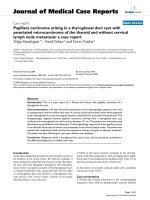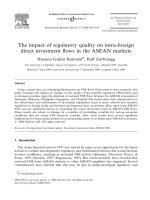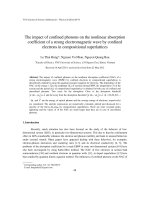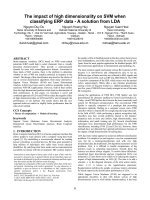Impact of lymphovascular invasion on lymph node metastasis for patients undergoing radical prostatectomy with negative resection margin
Bạn đang xem bản rút gọn của tài liệu. Xem và tải ngay bản đầy đủ của tài liệu tại đây (930.59 KB, 8 trang )
Kang et al. BMC Cancer (2017) 17:321
DOI 10.1186/s12885-017-3307-4
RESEARCH ARTICLE
Open Access
Impact of lymphovascular invasion on
lymph node metastasis for patients
undergoing radical prostatectomy with
negative resection margin
Yong Jin Kang1†, Hyun-Soo Kim2†, Won Sik Jang1, Jong Kyou Kwon1, Cheol Yong Yoon1, Joo Yong Lee1,
Kang Su Cho1, Won Sik Ham1 and Young Deuk Choi1*
Abstract
Background: The association between lymphovascular invasion and lymphatic or hematogenous metastasis has
been suspected, with conflicting evidence. We have investigated the association between the risk of biochemical
recurrence and lymphovascular invasion in resection margin negative patients, as well as its association with lymph
node metastasis.
Methods: One thousand six hundred thirty four patients who underwent radical prostatectomy from 2005 to 2014
were selected. Patients with bone or distant organ metastasis at the time of operation were excluded. Survival
analysis was performed to assess biochemical recurrence, metastasis and mortality risks by Kaplan-Meier analysis
and multivariate Cox proportional hazard regression. Odds of lymph node metastasis were evaluated by Logistic
regression.
Results: LVI was detected in 118 (7.4%) patients. The median follow-up duration was 33.1 months. In the Kaplan-Meier
analysis, lymphovascular invasion was associated with significantly increased 5-year and 10-year BCR rate (60.2% vs.
39.1%, 60.2% vs. 40.1%, respectively; p < 0.001), 10-year bone metastasis rate and cancer specific mortality (16.9% vs.
5.1%, p = 0.001; 6.8% vs. 2.7%, p = 0.034, respectively) compared to patients without LVI. When stratified by T stage and
resection margin status, lymphovascular invasion resulted in significantly increased 10-year biochemical recurrence rate
in T3 patients both with and without positive surgical margin (p = 0.008, 0.005, respectively). In the multivariate
Cox regression model lymphovascular invasion resulted in 1.4-fold BCR risk and 1.7-fold metastasis risk increase
(95% CI 1.045–1.749, 1.024–2.950; p = 0.022, 0.040, respectively). Lymphovascular invasion was revealed to be strongly
associated with lymph node metastasis in the multivariate Logistic regression (OR 4.317, 95% CI 2.092–8.910, p < 0.001).
Conclusion: Lymphovascular invasion increases the risk of recurrence in T3 patients regardless of margin status, by
accelerating lymph node metastasis and distant organ metastasis.
Keywords: Prostate, Radical prostatectomy, Prostate-specific antigen
* Correspondence:
†
Equal contributors
1
Department of Urology, Urological Science Institute, Yonsei University
College of Medicine, 50-1 Yonsei-ro, Seodaemun-gu, Seoul, Republic of Korea
Full list of author information is available at the end of the article
© The Author(s). 2017 Open Access This article is distributed under the terms of the Creative Commons Attribution 4.0
International License ( which permits unrestricted use, distribution, and
reproduction in any medium, provided you give appropriate credit to the original author(s) and the source, provide a link to
the Creative Commons license, and indicate if changes were made. The Creative Commons Public Domain Dedication waiver
( applies to the data made available in this article, unless otherwise stated.
Kang et al. BMC Cancer (2017) 17:321
Background
The association between lymphovascular invasion and
lymphatic or hematogenous metastasis has been suspected
since 1994, when the College of American Pathologists
recommended to routinely report lymphovascular invasion (LVI) for radical prostatectomy specimens; however,
current evidence remains controversial [1–5]. There are
several factors that make it difficult for LVI to establish its
value as an independent prognostic factor for recurrence.
Definitions of LVI vary from author to author, and there
are issues of overdetection with artifacts, all of which
contribute to the confusion regarding this particular
pathologic find��������������������������������������������������������������������������������������������������������������������������������������������������������������������������������������������������������������������������������������������������������������������������������������������������������������������������������������������������������������������������������������������������������������������������������������������������������������������������������������������������������������������������������������������������������������������������������������������������������������������������������������������������������������������������������������������������������������������������������������������������������������������������������������������������������������������������������������������������������������������������������������������������������������������������������������������������������������������������������������������������������������������������������������������������������������������������������������������������������������������������������������������������������������������������������������������������������������������������������������������������������������������������������������������������������������������������������������������������������������������������������������������������������������������������������������������������������������������������������������������������������������������������������������������������������������������������������������������������������������������������������������������������������������������������������������������������������������������������������������������������������������������������������������������������������������������������������������������������������������������������������������������������������������������������������������������������������������������������������������������������������������������������������������������������������������������������������������������������������������������������������������������������������������������������������������������������������������������������������������������������������������������������������������������������������������������������������������������������������������������������������������������������������������������������������������������������������������������������������������������������������������������������������������������������������������������������������������������������������������������������������������������������������������������������������������������������������������������������������������������������������������������������������������������������������������������������������������������������������������������������������������������������������������������������������������������������������������������������������������������������������������������������������������������������������������������������������������������������������������������������������������������������������������������������������������������������������������������������������������������������������������������������������������������������������������������������������������������������������������������������������������������������������������������������������������������������������������������������������������������������������������������������������������������������������������������������������������������������������������������������������������������������������������������������������������������������������������������������������������������������������������������������������������������������������������������������������������������������������������������������������������������������������������������������������������������������������������������������������������������������������������������������������������������������������������������������������������������������������������������������������������������������������������������������������������������������������������������������������������������������������������������������������������������������������������������������������������������������������������������������������������������������������������������������������������������������������������������������������������������������������������������������������������������������������������������������������������������������������������������������������������������������������������������������������������������������������������������������������������������������������������������������������������������������������������������������������������������������������������������������������������������������������������������������������������������������������������������������������������������������������������������������������������������������������������������������������������������������������������������������������������������������������������������������������������������������������������������������������������������������������������������������������������������������������������������������������������������������������������������������������������������������������������������������������������������������������������������������������������������������������������������������������������������������������������������������������������������������������������������������������������������������������������������������������������������������������������������������������������������������������������������������������������������������������������������������������������������������������������������������������������������������������������������������������������������������������������������������������������������������������������������������������������������������������������������������������������������������������������������������������������������������������������������������������������������������������������������������������������������������������������������������������������������������������������������������������������������������������������������������������������������������������������������������������������������������������������������������������������������������������������������������������������������������������������������������������������������������������������������������������������������������������������������������������������������������������������������������������������������������������������������������������������������������������������������������������������������������������������������������������������������������������������������������������������������������������������������������������������������������������������������������������������������������������������������������������������������������������������������������������������������������������������������������������������������������������������������������������������������������������������������������������������������������������������������������������������������������������������������������������������������������������������������������������������������������������������������������������������������������������������������������������������������������������������������������������������������������������������������������������������������������������������������������������������������������������������������������������������������������������������������������������������������������������������������������������������������������������������������������������������������������������������������������������������������������������������������������������������������������������������������������������������������������������������������������������������������������������������������������������������������������������������������������������������������������������������������������������������������������������������������������������������������������������������������������������������������������������������������������������������������������������������������������������������������������������������������������������������������������������������������������������l, LVI significantly
increased the metastasis risk (hazard ratio [HR] 1.738,
Kang et al. BMC Cancer (2017) 17:321
Page 4 of 8
Fig. 2 Kaplan-Meier curve for a BCR, b distant organ metastasis, c cancer-specific survival stratified by LVI
95% CI 1.024–2.950, p = 0.040). There were no significant associations for age, PSA, and PSM in the model,
while T stage 4, Gleason score ≥ 8, and lymph node metastasis retained statistical significance.
Logistic regression for lymph node metastasis
To investigate the influence of LVI on the lymph node
metastasis, logistic regression was performed (Table 3).
Pathologic T stage above 3, LVI, PSM, PSA above 20 ng/
mL, pathologic Gleason score above 8 were significantly
associated with lymph node metastasis in the univariate
analysis (all p < 0.001). With the parameters found significant in the univariate analysis, multivariate model was
constructed. Second to the Gleason score above 8 (odds
ratio [OR] 5.745, 95% CI 2.687–12.285, p < 0.001), LVI
was associated with high odds of concurrent lymph node
metastasis (OR 4.317, 95% CI 2.092–8.910, p < 0.001).
Elevated PSA above 20 ng/mL (OR 3.208 95% CI 1.647–
6.246, p = 0.001) and PSM (OR 3.697, 95% CI 1.462–
9.351, p = 0.006) were also associated with lymph node
metastasis. T3 stage did not show statistically significant
association in the multivariate analysis (p = 0.165).
Kang et al. BMC Cancer (2017) 17:321
Page 5 of 8
Fig. 3 Kaplan-Meier curve for BCR stratified by T stage and PSM
Discussion
Our study is, to our knowledge, the largest to demonstrate that LVI increases the recurrence risk in patients
with T3 tumors independent of resection margin status.
Our results indicate that increased BCR rate in LVI tumors is mainly mediated by increased lymph node metastasis, a cause different from residual cancer cells by
PSM cancers. Although previous studies generally agree
that LVI is associated with disease progression and aggressive tumor behavior, its value as an independent
prognostic factor remains debatable. According to Loeb
et al., LVI was not an independent predictor of progression in a multivariate model, although it showed a significant association with tumor volume, Gleason
score > 6, PSM, extraprostatic extension (EPE), positive
lymph nodes, and seminal vesicle invasion (SVI) [3].
Table 2 Cox regression for BCR and distant metastasis with LVI and other parameters as covariate
BCR
Distant metastasis
Univariate
Multivariate
Univariate
Multivariate
p-value
HR
95% CI
0.001*
1.001
0.990–1.012
p-value
p-value
HR
95% CI
p-value
0.855
0.048*
1.023
0.992–1.055
≥20
<0.001*
2.230
0.149
1.867–2.662
<0.001*
<0.001*
1.495
0.950–2.353
0.082
3
<0.001*
1.522
1.253–1.849
<0.001*
0.103
0.704
0.409–1.212
0.205
4
<0.001*
1.707
1.094–2.664
0.019*
<0.001*
2.399
1.026–5.611
0.043*
7
<0.001*
1.953
1.521–2.508
<0.001*
<0.001*
1.123
0.566–2.229
0.741
≥8
<0.001*
3.233
2.474–4.224
<0.001*
<0.001*
3.284
1.670–6.454
0.001*
PSM
<0.001*
2.125
1.775–2.543
<0.001*
0.005*
1.317
0.819–2.118
0.256
LVI
<0.001*
1.352
1.045–1.749
0.022*
<0.001*
1.738
1.024–2.950
0.040*
Lymph node metastasis
<0.001*
1.459
1.035–2.056
0.031*
<0.001*
5.083
2.954–8.749
<0.001*
Age (years)
Initial PSA (ng/mL)
Pathologic T stage
Pathologic Gleason score
LVI: lymphovascular invasion; PSM: positive surgical margin; PSA: prostate-specific antigen; NHT: neoadjuvant hormone therapy; HR: hazard ratio; CI:
confidence interval
*
statistically significant at p < 0.05
Kang et al. BMC Cancer (2017) 17:321
Page 6 of 8
Table 3 Odds of LVI for lymph node metastasis analyzed by multivariate logistic regression
Univariate
Multivariate
p-value
OR
95% CI
p-value
PSA (ng/mL)
≥20
<0.001*
3.208
1.647-6.246
0.001*
Pathologic T stage
≥3
<0.001*
2.216
0.722-6.803
0.165
Pathologic Gleason score
≥8
<0.001*
5.745
2.687-12.285
<0.001*
PSM
<0.001*
3.697
1.462-9.351
0.006*
LVI
<0.001*
4.317
2.092-8.910
<0.001*
LVI lymphovascular invasion; PSM positivie surgical margin; PSA prostate-specific antigen;OR odds ratio;CI confidence interval
Shariat et al., in their study involving 630 patients, have
concluded that a correlation between BCR and LVI is
mediated via an association with established features of
biologically aggressive prostate cancer, and that LVI is a
lethal phenotype of prostate cancer, leading to early metastasis and lower overall survival [2]. A close association
of LVI with features of aggressive disease were
highlighted again in the study by Yee et al. Whereas LVI
was shown to have an independent prognostic value of
its own in multivariate analysis, only marginal improvement was noted with the addition of LVI in the model,
rendering the parameter not clinically meaningful [4].
Conversely, other evidence suggests that LVI is an independent prognostic factor, aside from its close association
with the features of disease aggressiveness. Cheng et al. reported LVI to be an independent prognostic factor of BCR
and cancer-specific survival for clinically localized prostate
cancer patients, increasing BCR risk by 1.6 fold in their
multivariate model (95% CI 1.12–2.38) [15]. Similarly,
May et al. found that in addition to high Gleason score
(HR 3.51, 95% CI 2.06–6.00), LVI is the factor that significantly increases the BCR risk for organ confined cancer
patients (HR 4.39, 95% CI 2.47–7.80) [5]. Our results from
Kaplan-Meier analysis indicate that LVI increases BCR
rate and cancer-specific mortality up to 20% and 5%,
respectively (Fig. 2). Controlling for the other known parameters, our regression model found LVI to retain statistical significance in its association with increased BCR risk
(HR 1.352, 95% CI 1.045–1.749, p = 0.022). This disproves
the belief that the increased recurrences in the LVI
patients are due to the strong association with other established prognostic factors.
Especially in the cancers of T3 stage, we identified that
there exists difference in the pattern of disease progression between LVI positive and negative patients. Radical
prostatectomy has been not recommended on T3 patient
up until recently as it was reported to be rarely curative
[17]. However, from several randomized clinical trials,
operation is now proven to be a valid option as it grants
improved survival benefit in T3 patients [18]. Among
the factors associated with recurrence risk, incomplete
resection and unsuspected lymph node metastasis remains a major obstacle [17]. PSM suggests the presence
of remnant cancer in the prostate bed, whether viable or
not [19, 20]. It is recognized as a strong predictive factor
for BCR, and attempting regional control with radiotherapy is known to yield favorable results [21]. Along with
PSM, LVI is reported to increase BCR as well in T3 patients. Herman et al. evaluated pT3N0 disease and found
that LVI was an independent predictor of disease recurrence [13]. Similar conclusions were drawn from the
studies by Yamamoto et al. and Epstein et al., where LVI
was found to be an independent prognostic factor in
pT3a and pT3b tumors, respectively [1, 14]. Our results
indicate that both PSM and LVI increase BCR risk, but
in an independent manner. Presence of LVI significantly
increased BCR rate in both positive and negative resection margin T3 groups (Fig. 3) as well as in multivariate
model with PSM as a covariate (Table 2). It was shown
by Mitsuzuka et al. that, LVI can increase BCR risk without PSM in T2 patients (p < 0.001, HR 3.809) [22]. Our
result extends the finding to T3 cancers, adding to the
evidence that mechanism by which cancer progresses for
LVI positive cancer is different from PSM cancer where
local tumor recurrence is believed to be a major cause of
treatment failure [23].
LVI may serve as a portal of entry for systemic progress via regional lymph nodes. Liauw et al. [24] in the
study on the role of of SVI and LVI for salvage radiotherapy patients, they demonstrated that LVI was associated with increased risk of BCR after radiotherapy
(p = 0.019) and resulted in treatment failure in all
patients, concluding that salvage radiotherapy was ineffective in LVI patients. It is likely that this is due to
metastatic regions being present beyond the coverage of
radiotherapy but currently, little is known about the
association between LVI and metastasis regarding prostate cancer. Cheng et al. reported increased rate of LVI
in lymph node metastasis patients (61% vs. 20%,
p < 0.0001), but the evidence was inconclusive as LVI
was also increased in patients with several other established prognostic factors [15]. Shariat et al. also suggested the association between LVI and lymph node
metastasis by demonstrating that 5-year metastasis free
rate was significantly lower as 63.0% in LVI group, compared to 96.7% in no LVI group [2]. In search of
Kang et al. BMC Cancer (2017) 17:321
Page 7 of 8
association between LVI and metastasis, we identified
that LVI is associated with increased 10-year distant
organ metastasis rate (16.9% vs. 5.1%, p = 0.001). The association was independent of other prognostic factors in
the multivariate analysis (HR 1.738, 95% CI 1.024–2.950;
p = 0.040), and we speculate that increased progression
to metastatic disease stems from the early access to
lymphatic channel, as LVI (OR 4.317, 95% CI 2.092–
8.910, p < 0.001) was strongly associated with concomitant lymph node metastasis in our Logistic regression
model (Table 3). Only parameter to show stronger association than LVI was Gleason score ≥ 8 (OR 5.745),
which is a well-known prognostic factor of lymph node
metastasis [25]. According to our results, occult metastasis should be suspected when LVI is detected, and meticulous follow-up examinations for the evidence of
metastasis should be ready.
Our study has some important limitations. Firstly, no
discrimination between lymphatic and vascular invasion
has been made. While it is possible to identify blood vessels from the lymphatic channel by immunohistochemical analysis, its clinical significance is not clear, and we
have made no effort in describing the nature of vessels
[6]. In addition, due to the retrospective nature of our
study, radiologic images were interpreted by several
other radiologists, allowing possible inter-observer variations. Utilization of pre-set criteria in the prospective
setting may improve accuracy of results.
manuscript. WSJ, JKK, CYY, JYL, and WSH performed the statistical analyses of
collected data. YJK, KSC and YDC contributed in conception and
interpretation of the results. All authors read and approved the final
manuscript.
Conclusion
LVI increased the risk of recurrence in T3 patients independent of margin status. With its close association to
lymph node metastasis, occult metastasis via lymphatic
channel should be suspected in patients with LVI.
Received: 11 January 2017 Accepted: 30 April 2017
Additional file
Additional file 1: Raw patient parameters used in the analysis.
(XLSX 164 kb)
Abbreviations
BCR: Biochemical recurrence; ECE: Extracapsular extension;
LVI: Lymphovascular invasion; PSA: Prostate-specific antigen; PSM: Positive
surgical margin; SVI: Seminal vesicle invasion
Acknowledgements
Not applicable.
Funding
There was no funding provided in the current research.
Availability of data and materials
All data generated or analyzed during this study are included in this
published article [and its supplementary information files].
Authors’ contributions
YJK and YDC contributed in conception of the study. YJK and HSK
contributed in interpretation of the patient data and writing of the
Competing interests
There are no competing interests in conducting the current research.
Consent for publication
Not applicable.
Ethics approval and consent to participate
The current research was approved from the Severance hospital institutional
review board (protocol number 4–2015-0829). Informed consent from the
participants was waived by the institutional review board as the current
study satisfied all of the following requirements for the waiver of informed
consent:
– The research involved no more than minimal risk to the participants
(retrospective data analysis of previously collected medical records).
– The waiver did not adversely affect the rights and welfare of the
participants.
– The research could not practicably be carried out without the waiver
– The participants were provided relevant information afterwards when
necessary.
– The research was not subject to MFDS-FDA regulation.
Publisher’s Note
Springer Nature remains neutral with regard to jurisdictional claims in
published maps and institutional affiliations.
Author details
1
Department of Urology, Urological Science Institute, Yonsei University
College of Medicine, 50-1 Yonsei-ro, Seodaemun-gu, Seoul, Republic of
Korea. 2Department of Pathology, Severance Hospital, Yonsei University
College of Medicine, Seoul, Republic of Korea.
References
1. Epstein JI, Partin AW, Potter SR, Walsh PC. Adenocarcinoma of the prostate
invading the seminal vesicle: prognostic stratification based on pathologic
parameters. Urology. 2000;56:283–8.
2. Shariat SF, Khoddami SM, Saboorian H, Koeneman KS, Sagalowsky AI,
Cadeddu JA, et al. Lymphovascular invasion is a pathological feature of
biologically aggressive disease in patients treated with radical
prostatectomy. J Urol. 2004;171:1122–7.
3. Loeb S, Roehl KA, Yu X, Antenor JA, Han M, Gashti SN, et al. Lymphovascular
invasion in radical prostatectomy specimens: prediction of adverse pathologic
features and biochemical progression. Urology. 2006;68:99–103.
4. Yee DS, Shariat SF, Lowrance WT, Maschino AC, Savage CJ, Cronin AM, et al.
Prognostic significance of lymphovascular invasion in radical prostatectomy
specimens. BJU Int. 2011;108:502–7.
5. May M, Kaufmann O, Hammermann F, Loy V, Siegsmund M. Prognostic
impact of lymphovascular invasion in radical prostatectomy specimens. BJU
Int. 2007;99:539–44.
6. Kryvenko ON, Epstein JI. Histologic criteria and pitfalls in the diagnosis of
lymphovascular invasion in radical prostatectomy specimens. Am J Surg
Pathol. 2012;36:1865–73.
7. Pontius LN, Youngwirth LM, Thomas SM, Scheri RP, Roman SA, Sosa JA.
Lymphovascular invasion is associated with survival for papillary thyroid
cancer. Endocr Relat Cancer. 2016;23:555–62.
8. Mollberg NM, Bennette C, Howell E, Backhus L, Devine B, Ferguson MK.
Lymphovascular invasion as a prognostic indicator in stage I non-small cell lung
cancer: a systematic review and meta-analysis. Ann Thorac Surg. 2014;97:965–71.
9. Nakamura K, Ogoshi K, Makuuchi H. Subclassification of extranodal involvement
in gastric cancer patients. Hepato-Gastroenterology. 2010;57:968–74.
10. Tilki D, Shariat SF, Lotan Y, Rink M, Karakiewicz PI, Schoenberg MP, et al.
Lymphovascular invasion is independently associated with bladder cancer
Kang et al. BMC Cancer (2017) 17:321
11.
12.
13.
14.
15.
16.
17.
18.
19.
20.
21.
22.
23.
24.
25.
Page 8 of 8
recurrence and survival in patients with final stage T1 disease and negative
lymph nodes after radical cystectomy. BJU Int. 2013;111:1215–21.
Belsante M, Darwish O, Youssef R, Bagrodia A, Kapur P, Sagalowsky AI, et al.
Lymphovascular invasion in clear cell renal cell carcinoma–association with
disease-free and cancer-specific survival. Urol Oncol. 2014;32(30):e23–8.
Sivridis E, Giatromanolaki A, Galazios G, Koukourakis MI. Node-related factors
and survival in node-positive breast carcinomas. Breast. 2006;15:382–9.
Herman CM, Wilcox GE, Kattan MW, Scardino PT, Wheeler TM.
Lymphovascular invasion as a predictor of disease progression in prostate
cancer. Am J Surg Pathol. 2000;24:859–63.
Yamamoto S, Kawakami S, Yonese J, Fujii Y, Ohkubo Y, Suyama T, et al.
Lymphovascular invasion is an independent predictor of prostate-specific
antigen failure after radical prostatectomy in patients with pT3aN0 prostate
cancer. Int J Urol. 2008;15:895–9.
Cheng L, Jones TD, Lin H, Eble JN, Zeng G, Carr MD, et al. Lymphovascular
invasion is an independent prognostic factor in prostatic adenocarcinoma.
J Urol. 2005;174:2181–5.
Harris E, Lewin D, Wang H, Lauwers G, Srivastava A, Shyr Y, et al. Lymphovascular
invasion in colorectal cancer: an interobserver variability study. Am J Surg Pathol.
2008;32(12):1816–21.
Hodgson D, Warde P, Gospodarowicz M. The management of locally advanced
prostate cancer. Urol Oncol. 1998;4:3–12.
Ward JF, Slezak JM, Blute ML, Bergstralh EJ, Zincke H. Radical prostatectomy
for clinically advanced (cT3) prostate cancer since the advent of prostatespecific antigen testing: 15-year outcome. BJU Int. 2005;95:751–6.
Stephenson AJ, Eggener SE, Hernandez AV, Klein EA, Kattan MW, Wood DP
Jr, et al. Do margins matter? The influence of positive surgical margins on
prostate cancer-specific mortality. Eur Urol. 2014;65:675–80.
Swindle P, Eastham JA, Ohori M, Kattan MW, Wheeler T, Maru N, et al. Do
margins matter? The prognostic significance of positive surgical margins in
radical prostatectomy specimens. J Urol. 2005;174:903–7.
Chin JL. Post-radical prostatectomy management options for the positive
surgical margin: argument for adjuvant radiotherapy. Urol Oncol. 2009;27:87–8.
Mitsuzuka K, Narita S, Koie T, Kaiho Y, Tsuchiya N, Yoneyama T, et al.
Lymphovascular invasion is significantly associated with biochemical relapse
after radical prostatectomy even in patients with pT2N0 negative resection
margin. Prostate Cancer Prostatic Dis. 2015;18:25–30.
Yossepowitch O, Briganti A, Eastham JA, Epstein J, Graefen M, Montironi R,
et al. Positive surgical margins after radical prostatectomy: a systematic
review and contemporary update. Eur Urol. 2014;65:303–13.
Liauw SL, Webster WS, Pistenmaa DA, Roehrborn CG. Salvage radiotherapy
for biochemical failure of radical prostatectomy: a single-institution experience.
Urology. 2003;61:1204–10.
Adams J, Cheng L. Lymph node-positive prostate cancer: current issues,
emerging technology and impact on clinical outcome. Expert Rev Anticancer
Ther. 2011;11:1457–69.
Submit your next manuscript to BioMed Central
and we will help you at every step:
• We accept pre-submission inquiries
• Our selector tool helps you to find the most relevant journal
• We provide round the clock customer support
• Convenient online submission
• Thorough peer review
• Inclusion in PubMed and all major indexing services
• Maximum visibility for your research
Submit your manuscript at
www.biomedcentral.com/submit









